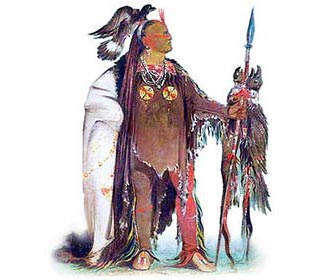Fast Facts about the History of Wyoming Indians
The climate, land, history, environment and natural resources that were available to the indigenous Indian tribes in Wyoming resulted in the adoption of the Great Plains Indians culture. - Name of State: Wyoming
- Meaning of State name: Named after a Dakota word meaning "large plains."
- Geography, Environment and Characteristics of the State of Wyoming: Eastern Great Plains rising to the foothills of the Rocky Mountains
- Culture adopted by Wyoming Indians: Great Plains Cultural Group
- Languages: Due to the number of migrant tribes in this area people spoke a variety of languages including Siouan, Algonquian, Caddoan, Uto-Aztecan and Athabaskan
- Way of Life (Lifestyle): Nomadic Hunters and farmers
- Types of housing, homes or shelters: Tepees were used by the nomadic hunters. The semi-nomadic tribes used tepees but also maintained permanent earth lodge villages situated along rivers, others built houses of grass. The farmers used Earth lodges
History Timeline of the Wyoming Indians - 10,000 BC: The first indigenous people were of the Paleo-Indian culture who lived in caves or were Nomadic Hunters using stone weapons
- 9000 BC: Clovis Culture (named after artefacts found at Clovis, New Mexico. These people used a distinctive type of fluted arrow point
- 7000 BC: Archaic Period in which people built basic shelters and made stone weapons and stone tools
- 2500 BC: Gulf Formational Period with development of ceramics and pottery
- 1000 AD: Woodland period with permanent houses and farming
- 1742: Francois and Louis Verendrye are the first white men to sight Wyoming
- 1775: 1775 - 1783 - The American Revolution.
- 1776: July 4, 1776 - United States Declaration of Independence
- 1778: Wyoming Valley Massacre - Iroquois allies of the Loyalist forces massacre white colonists
- 1803: The United States bought the Louisiana Territory from France for 15 million dollars for the land
- 1804: Lewis and Clark reach the area. Female Shoshone Indian guide Sacajawea (1788-1812) acted as interpreter and negotiator
- 1812: 1812 - 1815: The War of 1812 between U.S. and Great Britain, ended in a stalemate but confirmed America's Independence
- 1830: Indian Removal Act
- 1832: Department of Indian Affairs established
- 1861: 1861 - 1865: The American Civil War
- 1862: U.S. Congress passes Homestead Act opening the Great Plains to settlers
- 1865: The surrender of Robert E. Lee on April 9 1865 signalled the end of the Confederacy
- 1870's: The deliberate great slaughter of the northern bison herds to prevent the Native Indians continuing the Great Plains lifestyle
- 1874: Sioux expedition, Wyoming (Territory) and Nebraska
- 1876: Great Sioux War, aka the Black Hills War, (1876–1877). Battle of the Rosebud in Montana. Lakota Sioux and Cheyenne under Crazy Horse turned back soldiers commanded by General George Crook cutting off reinforcements intended to aid Custer at the Battle of Little Bighorn.
- 1876: Battle of Powder River was the opening battle of the Great Sioux War aka the Black Hills War, between the U.S. Army and the Sioux and Cheyenne
- 1887: Dawes General Allotment Act passed by Congress leads to the break up of the large Indian Reservations and the sale of Indian lands to white settlers
- 1890: Wyoming was admitted to the Union
- 1895: Bannock Uprising at Jackson's Hole, Wyoming
- 1969: All Indians declared citizens of U.S.
- 1979: American Indian Religious Freedom Act was passed
History of Wyoming Indians - Destruction and Decline
The history of the European invasion brought epidemic diseases such as tuberculosis, cholera, influenza, measles and smallpox. The Native Indians of Wyoming had not developed immunities against these diseases resulting in huge losses in population. Exploitation including the leverage of taxes, enforced labor and enslavement were part of their history, taking their toll on the Wyoming Indians. |
